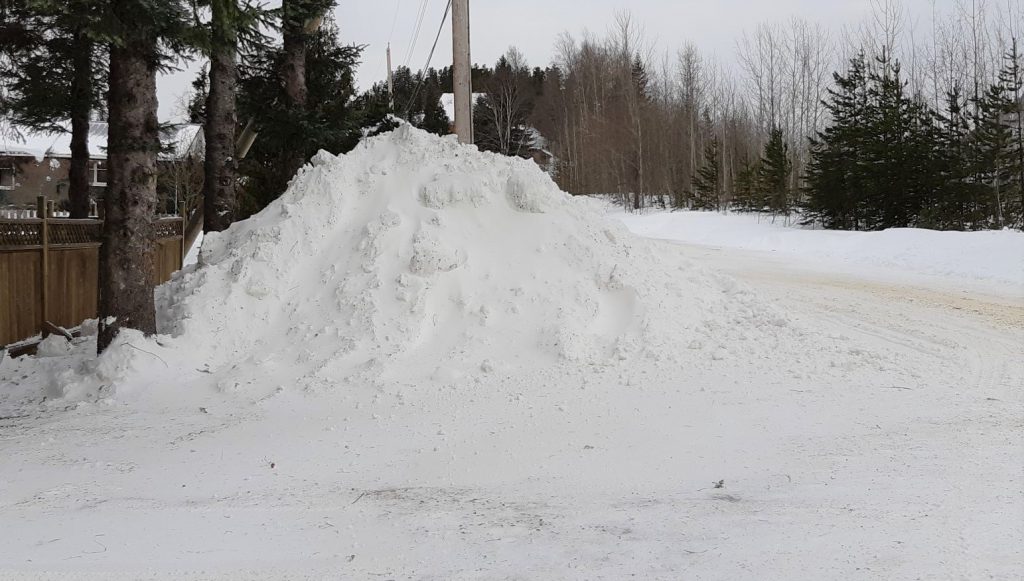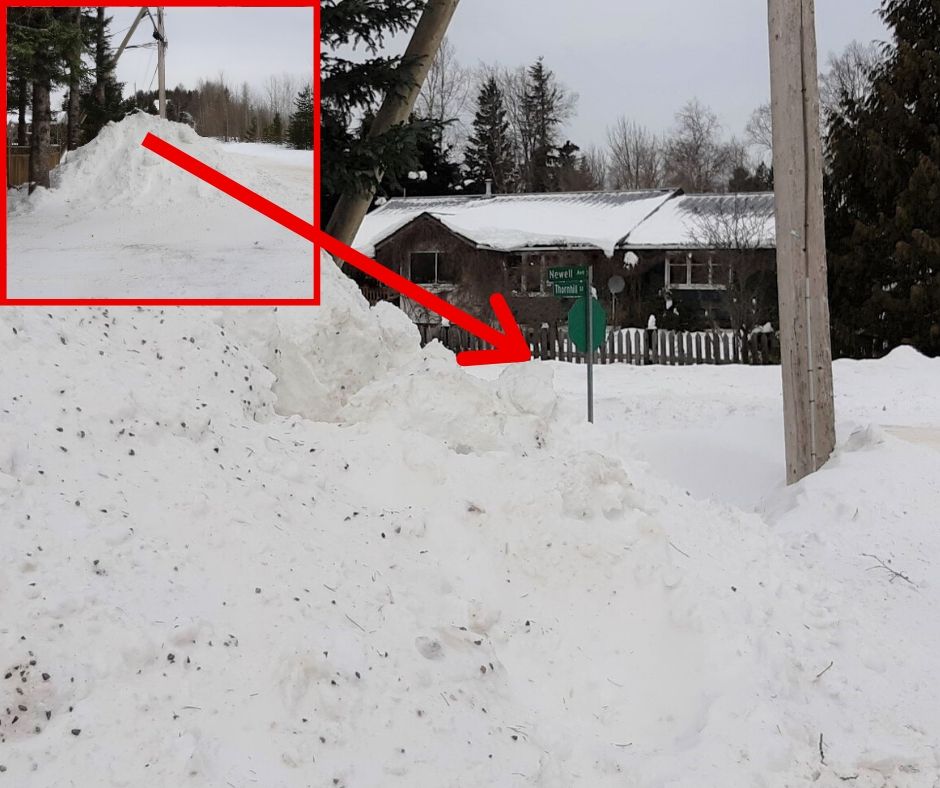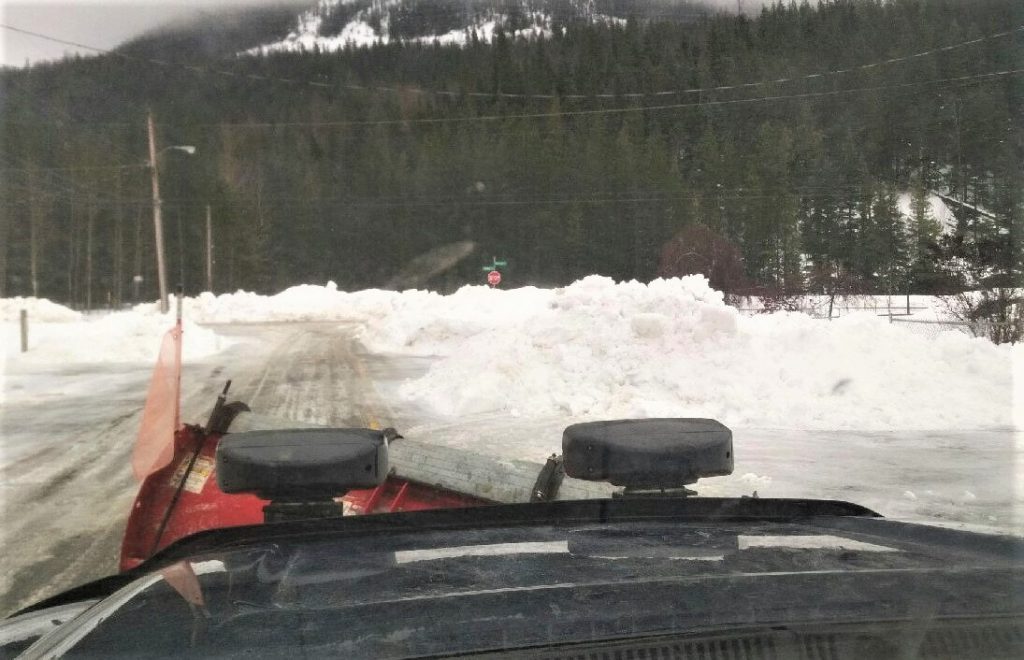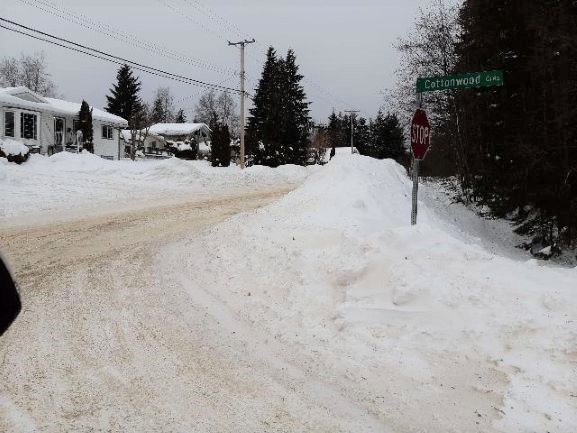
A “private snow” problem has landed on provincial roads in more populated parts of rural BC.
Some residents and property managers have been plowing their driveway snow onto ministry roads, and they need to know that their actions put people and property in peril. Here’s why it’s in your best interests and the public’s best interests, NOT to pile your snow on public roads.
#1 It’s Dangerous to Others
When snow from private properties encroaches on the roadway, motorists may have difficulty seeing oncoming traffic or pedestrians. The snow also reduces the space available for pedestrians and vehicles to share the road, and that can bring them dangerously close together in possibly slippery conditions.

#2 Snow Piles Interfere with Plowing
Piles of snow on ministry roads are also an issue for our maintenance contractors, because they’re obstacles to plowing. A grader and loader may have to be brought in to remove the snow. Our budgets are not intended for clearing “private snow” off public property.
When plows need to detour around piles of snow or can’t remove snow from the road, due to large deposits that must first be removed, then everyone who travels the area gets a lower level of maintenance.

#3 Drainage and Damage Problems
Piling snow onto boulevards and ditches is also a “snow-no.” Why’s that? Snow piles can interfere with drainage, causing damage to both public and private property. You could find yourself in a costly conflict with a neighbour or the Province of BC.
#4 It’s Against the Law
It’s actually illegal to move snow onto a public right of way (eg. provincial road, ditch, bridge or boulevard) under Section 62(1) of the Transportation Act. People who do that, may have to pay for the removal of the snow, if it’s deemed a safety hazard or a risk to damaging public infrastructure, or if it damages infrastructure.

In some communities, our maintenance contractors have delivered letters written by ministry operations managers, advising residents that their snow storage practices are in contravention of the Transportation Act. The letter asks property owners or managers to contain their snow within their properties, and encourages them to call our offices if they have any questions.
There’s “snow way” around it – when residents deposit the white stuff from their driveways onto ministry roads, boulevards or ditches, it’s a practice that needs to stop, for everyone’s safety.
Check out these blogs, for more information on how you and your property might connect with us:
- Driveway Culvert Maintenance Responsibilities on BC Highways: Your Questions Answered
- Who Ya Gonna Call? Your BC Transportation FAQs
- Development Approvals Deciphered – What It Is and Why it Matters to You
- Do You Have a Permit for That?
Have a question about plowing or winter maintenance? You’ll find lots of blogs on the topic on our website, or ask us below.
Can someone remove snow from their walkway and put it on the road to make a barrier for people who live beside them? Also prevents the garbage and recycling bins to be put out properly
Hi Lana – thanks for your comment. We aren’t sure what you mean by “make a barrier for people who live beside them”? We ask that you don’t put snow on the road at all. If you have particular concerns about snow removal in your area, or if you need room to leave carts at the curb, we suggest you connect with the service that does the collection to determine their recommendation. Hope this is helpful.
What are regulations on dumping your apartment driveway snow into the house across the street? Because that’s what my neighbours across the way did. I’ve contacted bylaw twice and at this point I’m just going to start shoveling it back into their driveway.
Hi Robyn, we don’t have any jurisdiction over that kind of thing in municipalities. I suggest you continue to seek a resolution with the apartment building owner/manager, and bylaw enforcement.
It’s illegal to shovel your driveway snow into ditches …
So where are people with a postage stamp yard to put it, down the toilet or out with the trash? Oh right, it’s a cash grab for snow haulers and storage facilities.
Hi there, Resident of Canada – thanks for sharing your opinion with us here.
This is stupid. Why would you ever take snow and move it to someone elses property without asking. I don’t think anyone would really do that so what was the point of having that on there?
Hi there Anonymous,
It’s a thing, according to our staff in more rural areas of the province. Folks not really understanding the impact their snow will have when it is piled up on the roadway, we suppose.
The snow plow is allowed to push public snow onto our driveways, where we are not allowed to put it in the ditch, and we’re not allowed to push it back onto the road. Are we allowed to open our driveway apron onto the road BEFORE the plow arrives to prevent the icy hump that damages our cars and is impossible to shovel? or do we have to call a full blown digging and hauling company every time? Because this seems like the government doesn’t care at all about the damage to passenger cars from the ice hump.
Hi Anonymous – thanks for your comment. Sorry – we aren’t clear what you mean by “open your driveway apron onto the road before the plow arrives”?
Actually, the apartment across the way did it to me last night. I’m about to start shoveling it back into their driveway.
Yes, no one likes to have to clear others’ snow.
Indeed
It is all well said not to shovel snow onto the road and I agree. Where is the snow that the snowplow and grader push into the driveways to be taken other than the sides of the driveway? When the snowplow drives by, the snow from the road flies right against our garage and onto our private property. When the grader comes, the nicely cleaned driveway gets blocked off with huge ice chunks and packed snow, which can not be removed with a snowblower. Elderly residents are unable to move these huge piles to exit or enter their driveway. Why does the grader not lift up the blade when going past a driveway. Or, have a small bobcat come right behind the grader and push all that heavy icy snow from the driveway entrance to the side? Do you know the frustration when a senior plows his driveway so he can get out of his driveway to go for a Doctor’s appointment, then sees the grader come by and plug the driveway up with huge ice chunks? Or when you come home from grocery shopping and you find the entrance to your driveway plugged with a huge icy snow pile you can not drive through nor climb over? There is no where to park your car because all other driveways in the neighborhood are also plowed in. There should be a law against that!!!!!
Hello Heidi – thanks for your message. We are sorry to hear your frustrations. Unfortunately, plow operators often have a vast amount of ground to cover and are required to ensure that the highways and side roads are cleared. If you would like to connect directly with the maintenance contractor in your area to discuss options for yourself and or your neighbours – we encourage you to do so. Here’s a list of our maintenance contractors listed by service area: https://www2.gov.bc.ca/gov/content/transportation/transportation-infrastructure/contracting-to-transportation/highway-bridge-maintenance/highway-maintenance/contacts#SA01
We hope that this is helpful.
But you can however plough a public road and use that snow to block off another public road 😂
Hi Lauren – sorry we are confused. Do you have a concern about road clearing that we can help with?
Who do you contact if you have a neighbor piling snow into the roadside ditch of your property and they are damaging the culvert, impacting drainage, and blocking sight lines?
Hi Mary – please contact our staff in your nearest ministry office. Here’s a link to them:
https://www2.gov.bc.ca/gov/content/transportation/transportation-reports-and-reference/regional-district-contacts
Hope that this helps.
Thank you
Some people have filled their ditches with dirt in Williams on Richland drive and water is pooling in the ditches creating unsafe conditions for small children
Hi there Neil,
Thanks for connecting with us here to share your concerns. We encourage you to reach out to staff in your local area office to discuss. Here is their contact info:
Cariboo District
301 – 640 Borland Street
Williams Lake, BC V2G 4T1
(Located in the Provincial Resource Building)
Telephone: 250 398-4510
Hope that this is helpful!
what about leaving residents unable to move thru there town for months as because a dead beaver plugged a culvert on aldous street in south hazelton .How about giving us a bailey bridge or a bridge so we who enjoy walking can do so.
Also on the lower end of dewar st in south hazelton we r lucky if we see a plow truck or a grader once maybe twice in a winter
Hello Jmm,
Thank you for sharing your comment and concern with us here.
We can confirm that these culverts are currently being repaired. We appreciate your patience during this time and apologize for any inconveniences this has caused. A new stream system is currently being put in place; however, we are waiting for permits to proceed on further work as this is a fish bearing stream. We hope that this helps clarify. If you have any other questions or concerns, please don’t hesitate to contact our local area office or the regional district office for more information.
Thank you for the information.
actually, when homeowners and property managers do this they become liable for anything that happens, accidents etc .. and most people don’t realize that..
This is correct, good point, if private home owners create a hazard on the road they may be found responsible if incidents occur.
What about when you plow snow onto my property and pile it onto my fences? Who fixes the fence?
Hi Mona – thanks for your comment. Any damage to private property resulting from snow removal should be covered by the maintenance contractor, please reach out to your local contractor to discuss your concerns in more detail. Here’s a list of our contractors:
https://www2.gov.bc.ca/gov/content/transportation/transportation-infrastructure/contracting-to-transportation/highway-bridge-maintenance/highway-maintenance/contacts
no I dont actually think thats true,